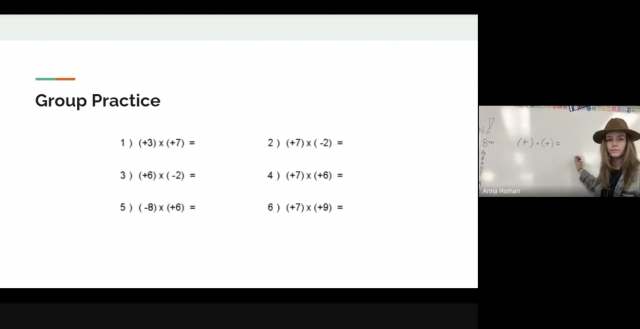
The first year of teaching can be stressful for any educator, but a school year starting in the midst of a pandemic has presented multiple uphill battles for Oklahoma’s first-year teachers to overcome. From adapting to technology to ensuring the emotional wellbeing of students during distance learning, this year’s tenderfoot teachers are facing unprecedented challenges.
“Every hurdle you might have as a first-year teacher in the classroom is amplified by 10,” eighth grade pre-algebra teacher Anna Homan said.
Homan began teaching at Roosevelt Middle School in Oklahoma City Public Schools this year through Teach for America, a program that recruits college graduates from fields other than education to enter the classroom.
When Homan initially joined the TFA program during her junior year of college as she pursued a degree in recreational therapy, she thought she had a general idea about how teaching at a public school would go. That changed this spring when the pandemic spread across America and Homan went through the TFA’s national institute — held virtually this year — and prepared to “enter” her classroom in the fall in person and/or digitally.
“My first thought was that it was essential that students had access to high-quality education, and that somehow we have to figure out how to provide it safely so they’ll be successful,” Homan said.
OKCPS started this school year with only online instruction, although the district’s youngest students will be returning to in-person classes as early as Oct. 19, which Homan says has presented challenges, such as adapting to the various programs used and outside factors that may affect her student’s ability to learn.
“Virtual learning is tough,” she said. “There was an overwhelming feeling — feeling nervous about what that would look like in practice and worrying about my students’ ability to focus at home. Maybe they don’t have the most supportive family or know where their next meal is going to be coming from. I’ve been thinking about all of the outside factors that were going to be amplified because of the pandemic and how to then be not just a good teacher, but a good adult figure in their life and someone they can rely on and have there for them despite these really challenging circumstances.”
Mitchel Williams is also starting his teaching career this year online as a sixth grade language arts and social studies teacher at Disney Elementary School in Tulsa through the Tulsa Teacher’s Corps.
“Working through how to navigate the website and making sure kids are learning the right thing has been the most challenging aspect of it,” Williams said. “A large part of our preparation had to do with caring for our students’ emotional wellbeing and ensuring — despite different barriers we have — that we’re providing an equitable education for our students.”
In-person classes during a pandemic
Molly Sykes has embarked on the first year of her education career at Southmoore High School teaching algebra II and pre-calculus. The school district has been holding a blended model of in-person instruction since they started their school year in August.
“I’m learning how I want to have my class room while having all these other balls thrown into the court. At university you’re taught that you can pick and choose what technology you want to use for your classroom, but now we’re being told that we’re supposed to use Canvas and all of these different technology tools,” Sykes said. “That part hasn’t been too hard for me to learn, but I think you see a lot of teachers struggle with that because they’re told all throughout their education that they can choose how they want to use technology in their classroom, but now they’re being told that they have to use certain programs.”
Aside from constantly sanitizing her classroom and calculators and learning new technology, Sykes says that since it’s her first year of teaching, she doesn’t necessarily have a comparison to teaching in a non-pandemic world. However, she does stay mindful of the impact going to school during these times can have on her students.
“I’ve definitely noticed some kids who come in and they say, ‘I was up all night, I’m so stressed,’ and I had one day where I told every class that if they’re working on my assignment for more than an hour and they don’t understand it I need them to stop and ask me the next day,” Sykes said. “They have enough going on right now and their mental health is more important to me than getting my assignment done.”
Looking out for students’ emotions
At the front of these teachers’ minds is how students are emotionally handling the pandemic, as well as the potential chaos of stressed home lives.
“I know that students need social and emotional support to overcome all the obstacles created by the pandemic, and I also know that school can be a safe place and an escape for a lot of kids,” Homan said. “Of course safety is number one, I don’t want any students coming back to school until it’s the right time. I just want them to be OK, and I want them to be safe and happy, and I know for this age group school can be such a vital role for them. Right now I’m just trying to make the best out of the situation, but hope that soon we’re able to safely return. I think that education is so vital and school provides not only that educational side, but that social outlet as well.”
Homan says that her experience working at in-patient psychological clinics during her undergraduate studies has been a vital key to helping her connect with and understand her students.
“I don’t think I would’ve been nearly as prepared to connect with the kids or to handle behavior interventions or anything if I hadn’t had that experience,” she said. “I think that every middle schooler and every teenager and every kid ever has a million things going on. If you’re not able to see the kid as a whole individual, I don’t think you can ever truly connect with them.”
Sykes’s school has a licensed professional counselor on campus, and Williams says keeping an eye out for problematic responses from his students has been one of his top priorities.

“We gauge how our students are doing throughout classes,” Williams said. “If I ask them how they’re doing and I have a student responding oddly, maybe they say they’re hungry or that they’re not doing well, it’s time for me to make a note of that to take to the counselor.”
Homan says part of her school’s insurance of the emotional wellbeing of their students has included reward systems for positive behaviors, events like drive-by parades and frequent check-ins with family members.
“A big thing for me has been positive call-ins and check-ins with their family,” she said “We had parent teacher conferences last week, and it makes me so happy to be able to tell parents how well their kids are doing. You can see the shift in kids.”
She says keeping students motivated throughout the coming months will be another challenge for all teachers, new and seasoned.
“The way to motivate them and connect with them is to really show them that you care, whether that be through asking about their favorite song or their favorite snack,” Homan said. “It’s also about making sure they feel themselves and see themselves being represented in their classrooms.”
As some school districts throughout the state evaluate their plans for returning to classrooms and others keep an eye on transmission rates to determine if they need to pursue online classes, Homan says it will be important to keep marginalized communities in mind. Community members should also remember that while teachers and students may want to be back in the classroom, safety needs to be a top concern.
“Give grace to students and teachers,” Homan said. “This is a whole new territory for everyone.”





















